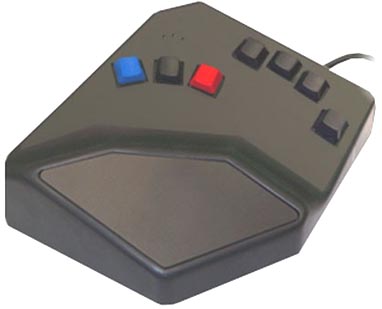Complex actions need specialized interfaces
Yesterday I was in a room with a Bloomberg terminal. Bloomberg is specialized software used by financial professionals to navigate data and take actions. Users interact with the system through a specialized keyboard that looks like this:

These keyboards are easy to laugh at, they look antiquated and ridiculous. They look kind of like toys for people who don’t know how to use real computers. But I really like them, or at least I like the underlying idea:
Specialized tools need specialized interfaces.
Keyboards are specialized text-entry devices. It’s easy to forget this because they are our main interface with computers, which are general-purpose engines. But it’s crazy to think that it is the best tool for every program, for every cognitive environment that we can imagine implementing in software. We knew this once but in the name of efficiency we have forgotten it.
Good history museums remind you that history is not a linear, predetermined progression. Natural history museums, for example, are fascinating not just because we can see the apes from which we descended but the vastly stranger evolutionary dead-ends. I feel the same way at the Computer History Museum. Looking back there seems to be a sort of Cambrian explosion in the late 60’s/early 70s where the fundamentals of our computers were beginning to fix in place, but the world was still wide open. This was when the mouse was invented, along with stranger beasts like the “chorded keyboard”, where you play different letters with different combinations of keypresses:

A BAT2 chorded keyboard. Source.
But even this is just a text input device. The keyboard is a workhorse because we have abstracted the computer towards it – because we had keyboards before computers.
But for highly specialized cognitive work, there may be better ways to interface. No one would try to play a piano with a computer keyboard and mouse. PC gamers and flight simulator use joysticks. Console gamers use specialized controllers. Why don’t we have better input devices for programming, for data analysis, for planning timelines and budgets. The Bloomberg keyboard, like the Apple touchbar, is a small halting step in this direction.
Related links:
- History of the bloomberg keyboard (note that even this keyboard has become more “conventional” over time)
- The Future of Programming talk by Bret Victor
- Doug Engelbart’s keyset device
Comments (1)
Gideon Potok
February 06 2018
Do you think that the apple touchbar is the start of a second cambrian explosion, made possible by the advent touch screens? One could perhaps argue that much of the interface with touch screens is customized for the software, though of course keypads are a ubiquitous part of the smart phone interface.
To leave a comment on this post, send me an email.
Revision History
(About)